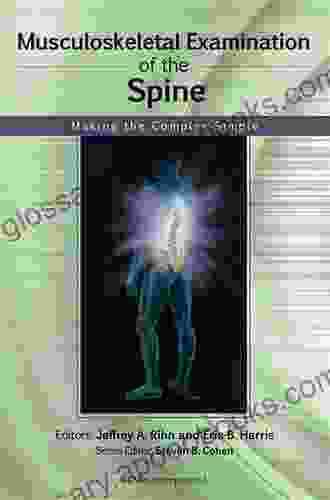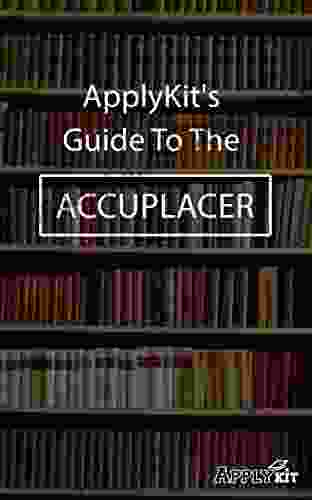Musculoskeletal Examination Of The Spine - An Indispensable Guide for Healthcare Professionals

The spine, the intricate framework that supports our bodies, is a marvel of engineering. However, this intricate structure is prone to various ailments and injuries that can lead to debilitating pain and impaired mobility. For healthcare professionals, a comprehensive understanding of musculoskeletal examination of the spine is essential for accurate diagnosis, effective treatment, and preventive care.
4.6 out of 5
| Language | : | English |
| File size | : | 11692 KB |
| Text-to-Speech | : | Enabled |
| Screen Reader | : | Supported |
| Enhanced typesetting | : | Enabled |
| Print length | : | 336 pages |
| X-Ray for textbooks | : | Enabled |
Overview
Musculoskeletal examination of the spine is a systematic approach to evaluating the musculoskeletal system of the spine. It involves a combination of history taking, physical examination, and specific tests to assess the range of motion, posture, muscle function, and neurological integrity. The goal of this examination is to identify any abnormalities or impairments that may be contributing to the patient's symptoms.
History Taking
The first step in the musculoskeletal examination is history taking. This involves obtaining a detailed account of the patient's symptoms, including their nature, duration, and severity. The healthcare professional should also inquire about any relevant medical history, such as previous injuries or surgeries, occupation, lifestyle factors, and medications.
Physical Examination
The physical examination is the cornerstone of the musculoskeletal examination of the spine. It involves several components:
- Observation: The healthcare professional begins by observing the patient's posture and gait. They may note any asymmetries, deformities, or muscle imbalances.
- Palpation: The spine is then palpated to assess for tenderness, swelling, or muscle spasm. The healthcare professional may also use specific maneuvers to test for nerve root irritation or instability.
- Range of Motion: The range of motion of the spine is assessed by asking the patient to perform various movements, such as flexion, extension, lateral bending, and rotation.
- Neurological Examination: A neurological examination is performed to evaluate the function of the nerves in the spine. This may include testing for reflexes, sensation, and muscle strength.
Specific Tests
In addition to the standard physical examination, specific tests may be necessary to further assess the spine. These tests may include:
- X-rays: X-rays provide images of the bones of the spine and can reveal any abnormalities in structure or alignment.
- Magnetic Resonance Imaging (MRI): An MRI uses magnetic fields and radio waves to create detailed images of the soft tissues of the spine, including the spinal cord and nerves.
- Electromyography (EMG): An EMG measures the electrical activity of muscles and nerves. It can help identify muscle weakness or nerve damage.
Interpretation and Reporting
The findings of the musculoskeletal examination are carefully interpreted to determine the underlying cause of the patient's symptoms. The healthcare professional may consider various factors, such as the history, physical examination findings, and results of specific tests. The examination report typically includes a summary of the findings, an assessment of the patient's condition, and recommendations for further evaluation or treatment.
Musculoskeletal examination of the spine is an invaluable tool for healthcare professionals in the diagnosis and management of spinal disFree Downloads. By performing a thorough and systematic evaluation, healthcare professionals can identify the underlying cause of the patient's symptoms and develop appropriate treatment plans to restore function and alleviate pain. This comprehensive guide provides an in-depth overview of the musculoskeletal examination of the spine, empowering healthcare professionals to deliver the highest quality of care to their patients.
Alt Attribute for Images
- Image 1: Healthcare professional performing a musculoskeletal examination of the spine on a patient.
- Image 2: Illustration of the spine and its various regions.
- Image 3: MRI image of the spine, showcasing its complex structure.
4.6 out of 5
| Language | : | English |
| File size | : | 11692 KB |
| Text-to-Speech | : | Enabled |
| Screen Reader | : | Supported |
| Enhanced typesetting | : | Enabled |
| Print length | : | 336 pages |
| X-Ray for textbooks | : | Enabled |
Do you want to contribute by writing guest posts on this blog?
Please contact us and send us a resume of previous articles that you have written.
 Book
Book Novel
Novel Page
Page Chapter
Chapter Text
Text Story
Story Genre
Genre Reader
Reader Library
Library Paperback
Paperback E-book
E-book Magazine
Magazine Newspaper
Newspaper Paragraph
Paragraph Sentence
Sentence Bookmark
Bookmark Shelf
Shelf Glossary
Glossary Bibliography
Bibliography Foreword
Foreword Preface
Preface Synopsis
Synopsis Annotation
Annotation Footnote
Footnote Manuscript
Manuscript Scroll
Scroll Codex
Codex Tome
Tome Bestseller
Bestseller Classics
Classics Library card
Library card Narrative
Narrative Biography
Biography Autobiography
Autobiography Memoir
Memoir Reference
Reference Encyclopedia
Encyclopedia Steven Harris
Steven Harris Debra Hester
Debra Hester Suzuhito Yasuda
Suzuhito Yasuda Heather Hapeta
Heather Hapeta Samuel W Mitcham
Samuel W Mitcham Luke E Lassiter
Luke E Lassiter Delia Iaboni
Delia Iaboni Jim Krosschell
Jim Krosschell Denise Mcmurray
Denise Mcmurray Stan Kirby
Stan Kirby Derek Sayer
Derek Sayer Diana Finlay Hendricks
Diana Finlay Hendricks Dennis Haugh
Dennis Haugh Jessie Gussman
Jessie Gussman Sonja Freisinger
Sonja Freisinger Ken Luball
Ken Luball Candi Cane Cooper
Candi Cane Cooper Susan Strange
Susan Strange Sherpaherb
Sherpaherb Delphi Classics
Delphi Classics
Light bulbAdvertise smarter! Our strategic ad space ensures maximum exposure. Reserve your spot today!

 Ashton ReedSignal Moon by Kate Quinn: A Tapestry of Courage, Sacrifice, and Unbreakable...
Ashton ReedSignal Moon by Kate Quinn: A Tapestry of Courage, Sacrifice, and Unbreakable...
 Bret MitchellTop Mistakes Women Car Buyers Should Avoid: Navigate the Maze with Confidence
Bret MitchellTop Mistakes Women Car Buyers Should Avoid: Navigate the Maze with Confidence Francis TurnerFollow ·15k
Francis TurnerFollow ·15k Walter SimmonsFollow ·6.9k
Walter SimmonsFollow ·6.9k Dwight BellFollow ·4.6k
Dwight BellFollow ·4.6k Thomas HardyFollow ·2.4k
Thomas HardyFollow ·2.4k Jared NelsonFollow ·8.2k
Jared NelsonFollow ·8.2k Charles DickensFollow ·13.6k
Charles DickensFollow ·13.6k Diego BlairFollow ·13.7k
Diego BlairFollow ·13.7k Shannon SimmonsFollow ·3.4k
Shannon SimmonsFollow ·3.4k

 Clarence Mitchell
Clarence MitchellCollection Of Handcrafted Plants For The Blackest Of...
Do you have a black...

 Edgar Hayes
Edgar HayesClassic Racing Mystery From The King Of Crime
Agatha Christie, the...

 Demetrius Carter
Demetrius CarterLafayette: Courtier to Crown Fugitive, 1757-1777
The Marquis de...

 Jared Powell
Jared Powell30 Gorgeous Sweaters, Cardigans, Hats, Toys & More:...
Immerse Yourself...
4.6 out of 5
| Language | : | English |
| File size | : | 11692 KB |
| Text-to-Speech | : | Enabled |
| Screen Reader | : | Supported |
| Enhanced typesetting | : | Enabled |
| Print length | : | 336 pages |
| X-Ray for textbooks | : | Enabled |












